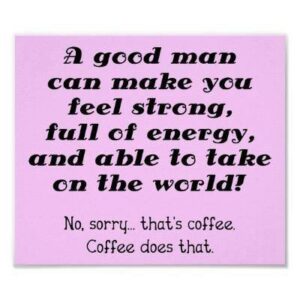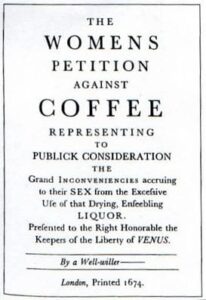It’s that time of year again: sit down with a cup of coffee and contemplate the universe. Hearing Economics once again enjoins readers to enthusiastically participate in International Coffee Day on September 29. Previously this space celebrated the virtues of coffee vis-a-vis health, productivity, technological advancements, and complementary goods, among other economically important aspects of this “awesome psychostimulant.”
 Coffee consumes two posts per year — one observes the holiday with meandering, self-indulgent comments; the other updates the ever-lengthening list of studies of coffee effects on our bodies and minds. The list is next week; indulgences are today with lots of pictures for psychostimulation.
Coffee consumes two posts per year — one observes the holiday with meandering, self-indulgent comments; the other updates the ever-lengthening list of studies of coffee effects on our bodies and minds. The list is next week; indulgences are today with lots of pictures for psychostimulation.
Apologies to those who think I’ve gone over the edge with this coffee thing (picture). They’re right, but I remain proud of my self-control, which limits coffee-obsessed discussion to just two posts per year.
First, a nod to productivity and Economics. Were it not for coffee and coffee houses, Economics, or at least its Bible, might not exist. Adam Smith wrote “The Wealth of Nation” in the British Coffee House, a famous water/coffee spot for Scottish intelligentsia back in the day. Locals gathered to read Smith’s latest drafts and joined in animated, coffee-fueled discussion. Those guys knew how to party.
 It’s Chemistry
It’s Chemistry
Coffee is 98% water, which isn’t too exciting. The joy of coffee is packed into the remaining 2%, which contains a host of interesting ingredients you can discover by clicking this video.
Not everyone is enamored of all things coffee — a cup can set you back $5, it makes some people jittery, adding sugar and cream makes you fat. But the energy and antioxidant effects derived from the caffeine in coffee are desired by most people, even those who don’t drink coffee.
 No surprise that two enterprising Harvard grads teamed up with a PhD chemist to create Sprayable Energy, an odorless liquid to spray on one’s body and slip in one’s purse, packaged in an attractively slim gold tube.
No surprise that two enterprising Harvard grads teamed up with a PhD chemist to create Sprayable Energy, an odorless liquid to spray on one’s body and slip in one’s purse, packaged in an attractively slim gold tube.
At pennies a spray, Sprayable Energy saves money and time, while welcoming sprayees “to the end of tired.” One spritz promises enhanced performance on tests, at work, at play, wherever. Professional baseball players can use it with impunity. Funding for this Indiegogo concept exceeds $84K from 1572 contributors to date (original funding goal was just $15K). It’s a winner.
Order in advance for your Audiology practice. Spray employees hourly to improve productivity, attitude, and your bottom line. Include a bottle with hearing aid sales to your active Boomer clientele. Sprayable Energy and moisture resistant hearing aids are natural economic complements: Life really is On, as Phonak assured us.
It’s A Mood Altering Substance
Chocolate and coffee are another complementary pair for Audiology practices. Pair them in kitchens, fitting rooms and waiting rooms to lift moods and encourage consumption.
The stimulating effects of caffeine are well documented and the Utility is beyond doubt: 120,000 tons of coffee consumption per year, worldwide, confirms the robustness of the market. And not just for Audiologists and patients. Even aliens are won over by the joys of coffee — click this incredibly cute video to see how our coffee-consuming Blue Planet might influence mood and consumption elsewhere in the universe.
It’s an Adult Drug, but Not Everyone Drinks or Chews Responsibly
FDA scrutiny forced venerable Wrigley to yank it’s newest product from US retail shelves in May, less than a month after its debut. The product was Alert Energy Caffeinated Gum, touted to have the equivalent of 1/2 cup of coffee in every stick. The concern has to do with the proliferation of caffeine-filled products aimed at children — everything from energy drinks to potato chips to gum. According to FDA Deputy Commissioner of Foods, Michael Taylor,
The FDA hasn’t reexamined the use of caffeine in food or drink since the 1950s, when it was approved for colas.
It’s FDA to the rescue, and just in time. Things are getting out of hand and a few hard-core baddies are ruining it for the rest of us hard-working, hard-drinking Audiologists. Consider Death Wish Coffee Co., which brags that it’s Extreme Coffee contains almost 200% more caffeine than the typical “sissy Starbucks” cup. It’s billed as “not for the weak” and at $79 for a 5-lb bag, that includes the weak and cheap of heart.
Adult caffeine addiction is the core message of Irn-Bru, the most popular soft drink in Scotland. Irn-Bru is definitely caffeine gone bad: it combines caffeine and quinine — surely not something Audiologists want to drink or recommend to patients. Their ads are as controversial as its ingredients. One features a senior citizen in a motorised wheelchair robbing a local shopping market of a supply of Irn-Bru.
Caffeine addiction hit rock bottom when David Hasselhoff donned white pajamas and ran around the beach singing “Thirsty for Your Love” in praise of iced coffee in the worst video ever made about coffee. In fact, it may be the worst video ever made about anything and we should not hold coffee responsible.
Those Who Don’t Know Coffee History are Doomed to Repeat It
Who among us can forget the Starbucks Fight with the Deaf witnessed this summer? Shameful spectacles of respected coffee houses, David Hasselhoff and Irn-Bru breaking bad serve as reminders of where this could end if we don’t drink responsibly.
 Starbucks is not the first coffee house to fall from grace into a den of iniquity, nor is our civilization the first to be endangered by the terrible consequencies of caffeine addiction. Consider the incipient Women’s Movement in 17th century Britain, which viewed coffee as the source of much evil when it came to men imbibing it. Indeed, there is a whole history linking coffee and sex:
Starbucks is not the first coffee house to fall from grace into a den of iniquity, nor is our civilization the first to be endangered by the terrible consequencies of caffeine addiction. Consider the incipient Women’s Movement in 17th century Britain, which viewed coffee as the source of much evil when it came to men imbibing it. Indeed, there is a whole history linking coffee and sex:
Women at one point blamed coffee for everything from homosexuality to lack of virility.
No doubt, coffee-loving men were imbibing in Ye Olde Publik Houses rather than staying home and doing chores. Mr. Coffee Machines and the sexual revolution addressed that vexing problem. Nowadays, both sexes inermix while enjoying coffee drinking in public and in the home.
Most infamously, consider the plight of the Ottoman Empire in 1633, when Sultan Murad IV laid down draconian coffee house laws to curb behavior of Turkish coffee imbibers.{{1}}[[1]]paraphrased from: Intoxication. Prohibition Table o p 49. Lapham’s Quarterly, VI(1), Winter 2013.[[1]] In the ensuing reign of terror, coffee houses were razed, repeat offenders were sewn into leather bags and thrown into the Bosporus, and soldiers who drank coffee before battles had their limbs crushed or were executed. Defiant coffee houses prevailed and continued to flourish in that civilization. That the Empire began it’s steep decline only 50 years later is probably a coincidence.
Let the defunct Ottoman Empire serve as a warning to Starbucks. Do NOT toss customers into the East River–regardless of their hearing status–unless of course they are singing badly and wearing pajamas.
Coffee as Art
Thankfully, the caffeine dialectic features far more good than bad, manifest by any number of beautiful art projects of all sizes and shapes throughout the world which are inspired by coffee. As examples:
Public art is found in abundance in Mexico City, including a gorgeous “portal of awareness” on Paseo de la Reforma made from almost 1500 red metal coffee cups. Coffee enhances alertness and awareness, the sculpture encourages those who walk through the portal to look around and become more aware of their surroundings. What a great place to relax with a cup of coffee.
There’s also fleeting and illusory art made in cups. Youtube is replete with videos on how to prettify coffee with steamed milk.
But now there is 3D latte art. This sculptural form began in Japan and is doubtlessly overtaking the global art world as this post is being written. Described as a “dangerous escalation of the global latte art movement,”
 3D latte art allows one to consume Hello Kitties and other foamed milk creations, limited only by your imagination. Or perhaps beyond most people’s imagination: what are we to make of the 3D latte melting clock a la Salvador Dali? Is that art imitating surrealism imitating an over-caffeinated life? What was Dali thinking? How much coffee did he consume? Is this art? Hearing Economics recognizes its limitations and must stop to have a cup of coffee and go back to contemplating the universe.
3D latte art allows one to consume Hello Kitties and other foamed milk creations, limited only by your imagination. Or perhaps beyond most people’s imagination: what are we to make of the 3D latte melting clock a la Salvador Dali? Is that art imitating surrealism imitating an over-caffeinated life? What was Dali thinking? How much coffee did he consume? Is this art? Hearing Economics recognizes its limitations and must stop to have a cup of coffee and go back to contemplating the universe.
Someone has probably created a 3D foam ear and even a 3D ear wearing a hearing aid, but I couldn’t find pictures to corroborate that assumption. If any reader comes across ear-level 3D latte art, I would appreciate receiving pictures and other documentation. Domo arigato in advance.
title picture courtesy of David Olenick











Holly,
For great coffee, come to Syros/.
Steve
On my way (I wish)!
Haha, this is great!
Thank you, much appreciated.
I’M 84 1/2 YEARS OLD AND HAVE NEVER HAD A CUP OF COFFEE…CAN’T STAND THE TASTE..NOT EVEN AS A TOPPING FOR TIRAMASU…ALSO JUST READ HOWARD SCHULTZ’S BOOK ON THE ALMOST DEMISE AND RESURRECTION OF STARBUCKS UNDER HIS LEADERSHIP…CANNOT UNDERSTAND THIS FASCINATION WITH SOMETHING WHICH IS SO BITTER AND WHEN HOT CAN HURT YOU…AHA ! ! IT IS THE HOPE OF SPILLING IT ON YOUR GENITALS AND COLLECTING $107MILLION FROM MICKEY D WHICH KEEPS FOLKS DRINKING IT……..zeke
So, I take it you’re not celebrating on September 29?
If you want to know the truth about the McDonald’s incident, check out the documentary Hot Coffee, which came out a couple of years ago. Pretty eye opening and surprising: https://www.hotcoffeethemovie.com/
Thanks for that response. I was debating whether to get into it or not. The corporate decision to save fractions of cents by keeping coffee hotter than necessary, despite knowing that people were being injured, is a classic illustration of the Stakeholder Paradox, described in a post several years ago. The harsh public treatment of that poor woman, who sustained significant injuries and even greater character injury is illustrative of powerful corporate ability to influence public opinion (if not that of the jury). Here’s a recent video reviewing the actual facts of the case: https://www.nytimes.com/video/us/100000002507537/scalded-by-coffee-then-news-media.html . I appreciate your comment’s doing the work for me.
Thanks for the mention. Don’t be put off by our name and caffeine content though. You may be surprised how enjoyable a cup of Death Wish Coffee can be. You probably will need only one 6oz or 8oz cup. This will greatly extend the life of our $79 – 5lb bag. Wishing you the best
DWCC
You’re welcome. I’ll definitely try your product. Thanks for your reply.